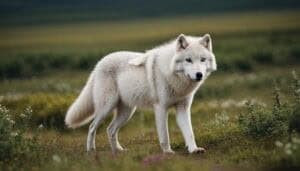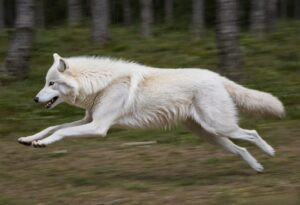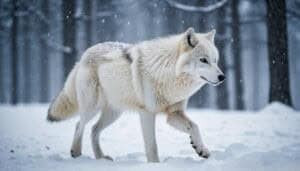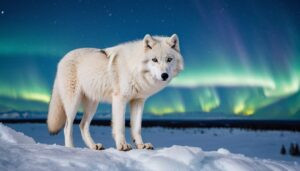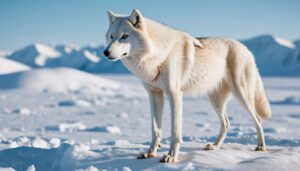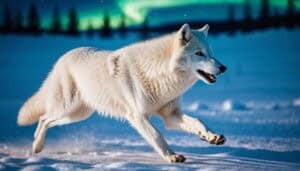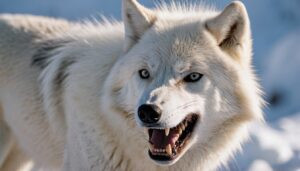Introduction
Arctic wolves are remarkable creatures, well-adapted to survive in the extreme conditions of the Arctic. One of their critical adaptations is their claws, which are specially designed to provide traction on ice
This article delves into the anatomy and unique features of Arctic wolves’ claws, their role in survival strategies, and the evolutionary and genetic factors behind these adaptations. We will explore how these claws aid in mobility, hunting, and defense, ensuring the wolves thrive in their icy habitat
Understanding the Anatomy and Adaptations of Arctic Wolves’ Claws
Arctic wolves possess unique anatomical features that enable them to navigate the icy landscapes of their habitat. Their claws are particularly vital in providing the necessary traction on ice, ensuring they maintain stability and mobility in challenging conditions
Structure and Composition of Claws
The claws of Arctic wolves are robust and slightly curved, designed to dig into icy surfaces and provide a firm grip. Unlike domestic dogs or wolves from milder climates, Arctic wolves have claws that are thicker and more durable
These claws are composed of keratin, a tough and resilient protein that forms the structure of the claws. Keratin allows the claws to remain sharp and strong despite the constant wear and tear from walking on ice and snow
One of the distinctive features of Arctic wolves’ claws is their sharp tips. These tips can penetrate hard-packed ice and snow, preventing the wolves from slipping
Additionally, the claws are supported by strong, muscular paw pads that distribute the wolf’s weight evenly, reducing pressure points and enhancing their grip
Specific Features Enhancing Traction on Ice
Several specific adaptations in the claws of Arctic wolves enhance their traction on ice
Firstly, the claws are non-retractable, meaning they are always extended and ready to provide grip. This is a crucial adaptation, as it ensures the wolves can quickly respond to changes in the terrain without needing to extend their claws manually
The surface of the claws also features small, microscopic ridges and grooves. These minute structures increase friction between the claws and the ice, further improving traction. This adaptation is similar to the tread on a car tire, which provides better grip on slippery surfaces
Moreover, the angle at which the claws are set into the paw is optimized for traction
The claws are angled slightly forward, allowing them to dig into the ice as the wolf moves, effectively acting as natural crampons. This positioning helps the wolves maintain their balance and stability, even when traversing steep or uneven icy surfaces
Functionality in Extreme Cold
Arctic wolves’ claws are also adapted to function effectively in extreme cold temperatures
The keratin in the claws remains hard and durable even in sub-zero temperatures, preventing brittleness that could lead to breakage. The blood flow to the paws and claws is regulated to keep them at an optimal temperature, ensuring the claws retain their strength and functionality
The claws’ structure minimizes the risk of frostbite, a common issue in extreme cold. The thick keratin layer provides insulation, while the underlying blood vessels maintain circulation, keeping the claws healthy and functional
Comparison with Other Wolf Species
Comparing Arctic wolves’ claws with those of other wolf species reveals significant differences tailored to their respective environments
For example, gray wolves, which inhabit more temperate regions, have claws that are less robust and slightly more curved. These claws are adapted for a variety of terrains, including forests and plains, where the need for ice traction is less critical
In contrast, the red wolf, another species found in warmer climates, has even less specialized claws, focusing more on speed and agility rather than traction on ice. This comparison highlights the unique adaptations of Arctic wolves, emphasizing the evolutionary pressure of their icy habitat
The stark differences in claw structure and functionality across wolf species underline the importance of these adaptations for survival. Arctic wolves have evolved specific traits in their claws that directly address the challenges posed by their harsh environment, showcasing nature’s remarkable ability to tailor species to their habitats
Claws and Survival Strategies of Arctic Wolves
The claws of Arctic wolves are not only crucial for providing traction on ice but also play an integral role in their overall survival strategies. These adaptations help the wolves navigate their environment, hunt effectively, defend themselves, and maintain their claws in optimal condition
Role in Mobility and Traction
Mobility is essential for the survival of Arctic wolves, who must traverse vast distances in search of food and shelter
The claws of Arctic wolves provide the necessary traction to navigate the slippery, icy terrain of the Arctic. This is especially important during the harsh winter months when the ground is often covered in ice and snow
The non-retractable nature of the claws ensures they are always ready to grip the surface, providing stability as the wolves move. The sharp tips of the claws can penetrate ice and packed snow, preventing slips and falls that could result in injury
Additionally, the claws’ slightly curved shape allows for better anchoring into the ground, giving the wolves the ability to make sudden turns and stops when chasing prey or avoiding predators
This traction is crucial not just for movement but also for hunting. Arctic wolves rely on their ability to chase down agile prey such as caribou and Arctic hares. The enhanced traction provided by their claws allows them to maintain high speeds and agility on ice, increasing their chances of a successful hunt
Importance in Hunting and Defense
Arctic wolves’ claws are indispensable tools for hunting. When pursuing prey, the ability to grip and maneuver on ice gives the wolves a significant advantage
Once the prey is caught, the claws help the wolves hold onto and subdue it. The claws’ strength and sharpness can cause significant damage to prey, making it easier for the wolves to immobilize their target
In addition to hunting, the claws serve a defensive purpose. Arctic wolves are not the top predators in their environment; they must contend with other carnivores like polar bears. The claws can be used to fend off attackers, providing a means of self-defense
During territorial disputes with other wolves, the claws also play a role in establishing dominance and protecting the pack. The versatility of the claws in both offensive and defensive situations highlights their critical role in the survival of Arctic wolves
Interaction with Paw Pads
The interaction between the claws and paw pads of Arctic wolves is another key aspect of their adaptation
The paw pads are thick and cushioned, designed to withstand the harsh conditions of the Arctic. These pads provide insulation against the cold ground and distribute the wolf’s weight evenly, reducing the pressure on the claws and preventing them from sinking too deeply into the snow
The combination of sharp claws and sturdy paw pads allows Arctic wolves to maintain balance and stability on uneven, icy surfaces. The paw pads also have small, rough textures that, combined with the claws, enhance the overall grip of the wolf’s paws
This dual traction system ensures that the wolves can move efficiently and safely across their environment
Maintenance and Condition of Claws
The maintenance of claws is crucial for Arctic wolves, as damaged or worn claws can hinder their ability to hunt and move effectively
Wolves naturally maintain their claws through their daily activities. Walking and running on ice and snow helps to wear down the claws, preventing them from becoming too long. Additionally, chewing on bones and other hard objects helps to keep the claws sharp and in good condition
Wolves are known to dig in the snow to create dens or search for prey, which also helps to file down their claws. The natural wear and tear from these activities ensure that the claws remain functional and effective
Interestingly, there are observations of Arctic wolves exhibiting behaviors that seem aimed at claw maintenance
For instance, wolves may scratch against ice or hard surfaces, which could help to sharpen their claws and remove any damaged outer layers. This behavior indicates a level of self-care that is crucial for their survival
Evolutionary and Genetic Perspectives
The claws of Arctic wolves are a result of millions of years of evolution, fine-tuning these animals to survive and thrive in one of the planet’s most inhospitable environments. Understanding the evolutionary development and genetic basis for these adaptations provides insight into how Arctic wolves have become so well-suited to their icy habitats
Evolutionary Development of Claws
The evolutionary journey of Arctic wolves has been shaped by the harsh conditions of the Arctic
Over generations, wolves that possessed traits beneficial for survival in this environment—such as enhanced traction on ice—were more likely to survive and reproduce. This process of natural selection gradually led to the development of claws that are particularly adept at gripping ice and snow
Fossil evidence indicates that the ancestors of modern Arctic wolves began to diverge from other wolf populations around 10,000 years ago, at the end of the last Ice Age. As the climate cooled and the Arctic region expanded, wolves that could effectively navigate icy terrains had a significant survival advantage
These adaptations included not only changes in claw structure but also other physiological and behavioral traits that supported life in the Arctic
One of the key evolutionary adaptations is the development of non-retractable claws
While many feline species have retractable claws to protect them from wear when not in use, the constant need for traction in Arctic wolves has favored claws that are always ready to grip the ice. This evolutionary trait ensures that Arctic wolves are always prepared to move swiftly and efficiently across their frozen habitat
Genetic Basis for Claw Adaptations
The adaptations seen in the claws of Arctic wolves are underpinned by genetic variations that have been naturally selected over generations. These genetic differences influence the development and maintenance of the claws, ensuring they are optimized for the Arctic environment
Studies of the Arctic wolf genome have identified specific genes associated with keratin production. Variations in these genes can affect the hardness, thickness, and growth rate of the claws. Enhanced keratin production results in claws that are more robust and better suited to the rigors of icy terrain
Additionally, genetic research has uncovered differences in the regulation of blood flow to the extremities
Arctic wolves have adapted to maintain adequate blood flow to their paws and claws even in extreme cold, preventing frostbite and ensuring that the claws remain functional. This genetic adaptation is crucial for maintaining the health and effectiveness of the claws in sub-zero temperatures
Comparison with Other Arctic Animals
The claws of Arctic wolves can be compared with those of other animals living in similar environments to understand the convergent evolutionary adaptations that occur in response to similar environmental pressures
For example, the claws of polar bears, another top predator in the Arctic, also show adaptations for traction on ice. Polar bears have large, non-retractable claws that provide grip on slippery surfaces, much like those of Arctic wolves
Similarly, Arctic foxes, though smaller, have claws that are adapted to their icy habitat. These claws are sharp and slightly curved, helping the foxes to dig through snow and ice to find food or create dens. The parallel adaptations seen in these different species highlight the importance of claw structure in Arctic survival
The comparison with these animals underscores the effectiveness of the specific adaptations seen in Arctic wolves. While each species has unique traits suited to its lifestyle, the common requirement for traction on ice has led to similar evolutionary solutions across different animals
Conclusion
Arctic wolves are exemplary models of adaptation, showcasing how evolution shapes animals to thrive in specific environments. Their claws, essential for traction on ice, embody a series of anatomical, functional, and genetic modifications that support their survival in the harsh Arctic climate
We first explored the anatomy and adaptations of Arctic wolves’ claws, noting their robust, sharp structure designed for maximum grip. We examined how these claws provide enhanced traction on icy surfaces, their functionality in extreme cold, and the unique features that differentiate them from the claws of other wolf species
Next, we delved into how these claws contribute to the survival strategies of Arctic wolves. The claws’ role in mobility and traction ensures that the wolves can navigate the slippery terrain of the Arctic with stability and efficiency
We also discussed the importance of claws in hunting and defense, emphasizing their role in capturing prey and protecting against predators. The interaction between the claws and paw pads further enhances the wolves’ ability to traverse their icy habitat
The evolutionary and genetic perspectives highlighted how natural selection has fine-tuned these adaptations. The development of non-retractable claws, genetic variations in keratin production, and mechanisms to maintain blood flow to extremities all contribute to the Arctic wolves’ ability to thrive in their environment
Comparisons with other Arctic animals, like polar bears and Arctic foxes, underscored the convergent evolution that occurs in response to similar environmental pressures
Overall, Arctic wolves’ claws are a testament to the power of evolution and adaptation. These remarkable features enable them to survive and flourish in one of the most challenging habitats on Earth, demonstrating the intricate and fascinating ways in which life adapts to its surroundings



